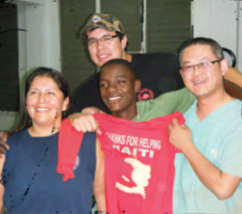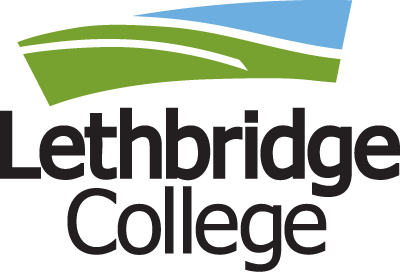 When the earthquake struck the Caribbean country in January, many responded with financial aid and boots-on-the-ground assistance. Among the latter was a group from the Blood Tribe, led by paramedic Lan Ngo, a Lethbridge College alumnus.
When the earthquake struck the Caribbean country in January, many responded with financial aid and boots-on-the-ground assistance. Among the latter was a group from the Blood Tribe, led by paramedic Lan Ngo, a Lethbridge College alumnus.
Lan Ngo is at the top of his game. A paramedic, the elite of the emergency medical corps this side of the hospital doors, he’s also a trained nurse. The combination of knowledge and experience allow him to earn a healthy wage in a profession he loves.
For 10 days last spring, though, Ngo was paid in a much difference currency: the smiles of gratitude flashed by Haitian children he and his team from the Blood Tribe Department of Health were able to help in the post-earthquake mayhem engulfing the Caribbean island.
He came back far richer for the experience.
“Those smiles were the only thanks I needed,” says Ngo. “There were a lot of orphans and children who were dropped off by their parents in the hope we could help them. Many had never had someone ask them if they needed help before. We brought them happiness.”
The Blood Tribe knew in February it wanted to reach out to Haiti in the aftermath of the earthquake that had destroyed most of the poverty-stricken nation’s infrastructure the previous month. It would be the community’s chance to even the score after the assistance it received from the Red Cross during the southern Alberta flood of 1995.
“The position of the department was ‘we’re always taking; here’s our chance to give back for once,’” says Ngo. “We had no money to send, and others were taking care of that anyway. But we had our expertise to lend.”
Ngo and Dr. Esther Tailfeathers, who works in Standoff and in emergency at Cardston and Fort Macleod, envisioned taking a four-member team to Haiti, but when word got out on the reserve, the number of those wanting to help grew dramatically. Finally, 13 made the cut, including non-medical personnel who provided vital logistical support in Port-au-Prince.
“We selected them not for what they knew, but for how they approached the task ahead,” says Ngo. “We knew things they would be seeing in Haiti would be traumatic.”
WestJet chipped in the flights from Canada to Haiti, a major contribution which allowed the team to spend donations from other sources on medical supplies, from gauze bandages to antibiotics. Dearest to Ngo’s heart was a $700 donation from students of Standoff Elementary School. Team members used
a lot of their own money, and took vacation time or traded shifts to make the 10-day journey in late March.
Under the guidance of the Quisqueya Crisis Relief Centre, the team established a medical beachhead close to the shattered presidential palace in Port-au-Prince, a MASH-style unit amid a sprawling tent city built by Haitians now too frightened to enter buildings. They worked alongside German, American,
Spanish and other caregivers who had responded to the tragedy. The U.S. military provided protection, while the Mexican navy impressively ferried in daily medical teams to provide wound care.
Bureaucracy could make one weep at times. Ngo witnessed truckloads of food stuck in warehouses, private hospitals closed for want of funding, and a burgeoning black market selling necessities that should have been available from the proper authorities. Profiteers jacked prices to where a box of
Advil sold for $20, more than most can afford. Garbage was everywhere, spawning parasites, and portable toilets, erected in a long row by the U.S. army for those in the tent city, stood full and overflowing into the street.
For the team, the major foe was infection, compounded by its allies - scabies, lice, roundworms, STDs and other nasty sideshows - just in case injuries suffered in the earthquake weren’t enough to devastate the populace, some 46,000 crammed into a one-kilometre radius.
Imagine the enormity of the problem facing the Blood Tribe team in its tiny slice of this damaged nation. It’s 5 a.m. and already the daily line-up stretches down the block outside the tent. Team members have awakened from their own tents and have made the trip to their medical station in the back of a truck, caged, much like prisoners for their security.
Before the first patient is seen, everyone knows the day will end with that heartbreaking moment 12 hours later when those at the end of the line must be told there is nothing left to give them.
Orphans, some five years old, need medicine, but are too young to comprehend the instructions for its safe ingestion, or easy victims for black marketers who will steal the drugs for resale. Many are dehydrated and require electrolytes through IV drips. Those can be established, but once they’re rehydrated, they have to leave; the required continuous care is impossible amid the size of the problem.
Children missing limbs are a common site; those in wheelchairs are in danger of having them stolen and sold on the black market. People wear high-end clothing – Lacoste, DKNY – raided from the local factories in which they’re made for sale to the affluent elsewhere who can afford them. Perhaps that’s just karma at work.
The day’s care begins. Patients are sorted by their needs and funnelled to the caregivers. Sometimes, translation runs through English to French to Spanish to Creole, which can make crucial understanding at best chancy. The team knows the lack of ongoing care will, in many cases, hinder healing, but members soldier on through the heat of the day.
“You always have to remember you are a guest in their country,” says Ngo. “You’re there to help, but you must always show respect.”
The team met a Haitian medical student who missed classes the day the earthquake killed many of his friends and classmates; he took on 300 patients.
Ngo and his team assess patients without access to lab work such as blood tests and ultrasound. Because of the stringent Catholic beliefs here, they are unable to hand out condoms or other birth control.
Teens form the heads of many households, their parents dead or missing. Some will go three days without food or water, the rain their only source of safe drinking water. Modesty is a forgotten luxury. Some resort to selling the Canadians’ free drugs for food, the more important commodity; often, their customers buy the wrong prescriptions.
The day creeps toward 5 p.m. and the team begins to prepare to return to its tents. Patients remain in line, only to be told there is nothing left for them. Still, there is a sense of accomplishment; spirits remain high.
After returning home, Ngo recounts his experiences for Lethbridge College EMT students, stirring in them a desire to one day be involved in similar mercy operations. For Ngo, the largest question left in Port-au-Prince is unanswered.
“When all the aid leaves, what will happen? It’s a question the world has to ask.”
Lan’s team in Haiti:
Dr. Esther Tailfeathers, MD- family medicine and rural ER
Veronica Oka-Wells- medical documentation expert and team treasurer
Wayne White- wilderness emergency training, medical supplies and cargo organizer
Barbara Williams Freeman, RN- infection control
Cheason White, RN- orthopedics
Paulette Anulis, RN- Foothills Hospital ICU (a native Haitian who lost family)
Suzanne Pecht- paramedic, rural emergency
Sara Hunt, EMT- rural emergency
Matt Down, EMT- rural emergency
Doris Iron Shirt, LPN- wound care and rural home care
Joanne Wells- community health representative, infection control and tuberculosis
Eldon Jon Davis, EMT- rural emergency
A one-man paramedic crew
Lan Ngo added a nursing diploma to his repertoire to broaden his understanding of the system. Now he takes his expertise to the street, the hospital ward and the classroom.
Perhaps he considers it a tribute to his past.
At four years old, Lan Ngo arrived in Canada, one of the “boat people” who fled Vietnam after the communist takeover of the south. Raised in Lethbridge, at 20 he harnessed his self-described “type A” personality to become a paramedic, graduating from SAIT in 2000.
Ngo (the “g” is silent) worked the streets of Calgary for five years, repeatedly picking up the same people he knew would not receive the care they required to keep them safe.
“I kept wondering why these people were not being looked after,” says Ngo. “I decided to become a nurse to see where they were falling through the system’s cracks. Part of the reason for this in Calgary is there is no holistic approach to healing, unlike that found in Lethbridge.”
He graduated from Lethbridge College’s Nursing program in 2006 and became intrigued with psychiatric nursing, a position he says allows him to take a broader approach to client care. In Lethbridge, patients receive assistance with finances, housing, spiritual care and coping mechanisms, thus reducing the drain on health care.
“I find I can use my nursing skills on the street as a paramedic,” says Ngo. “At the end of the day, in Lethbridge the patient gets the care required.”
His career as a paramedic affords him a different role every day, a diversity he needed to keep his focus.
“Our office is outside, where a nurse’s office is in a hospital,” says Ngo. “One day I can be transferring a patient to Foothills, or pulling someone from a ditch at 40 below. I love the challenge.”
Ngo works as a paramedic for the Blood Tribe Department of Health, as a nurse in Fort Macleod, as a psychiatric nurse at Chinook Regional Hospital, serves with the Pincher Creek and Coaldale EMS units and teaches a course at Lethbridge College.


